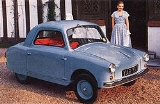
Opperman
Encyclopedia
S E Opperman was a tractor
manufacturer in England
. After he saw the Bond car
he decided to build his own four-wheel microcar
at a factory in Elstree
, Hertfordshire.
The first model was the Model "T" Unicar, designed by Laurie Bond and built between 1956 and 1959. It looked like a miniature two door saloon with 2+2 seating and was the cheapest car at the 1956 London Motor Show, but it was even cheaper if built as a kit when it could be had without engine for £170. A complete car cost £400. The body was made in fibreglass mounted on a steel tube chassis and had neither bonnet
nor boot lid. The engine was placed in the middle of the rear seating area giving two small seats on either side of the engine. Since it had no differential for the rear wheels they were placed close together. The front suspension was independent using coil springs and struts and at the rear trailing arms were used. The brakes were mechanically operated. It was powered by a 328 cc Excelsior twin-cylinder, air-cooled, two-stroke engine giving 18 bhp and a top speed of 45 mph (72 km/h). Some early models had an Anzani
engine. About 200 were made.
The only other Opperman was the Stirling, but only two were made, built between 1958 and 1959. Much more stylish than the Unicar, the first had a larger 424 cc 25 bhp Excelsior engine and the second had a Steyr 500 cc unit. The brakes were now hydraulic and the rear wheels further apart. The launch of the Mini
in 1959 wiped out the rationale for the Opperman and the Stirling never went into full production.
Tractor
A tractor is a vehicle specifically designed to deliver a high tractive effort at slow speeds, for the purposes of hauling a trailer or machinery used in agriculture or construction...
manufacturer in England
England
England is a country that is part of the United Kingdom. It shares land borders with Scotland to the north and Wales to the west; the Irish Sea is to the north west, the Celtic Sea to the south west, with the North Sea to the east and the English Channel to the south separating it from continental...
. After he saw the Bond car
Bond Cars Ltd
Bond Cars Ltd was a British car maker. Initially called Sharps Commercials Ltd, it changed its name to Bond Cars Ltd in 1963. The company was taken over by the Reliant Motor Co Ltd of Tamworth, Staffs in 1970 who quickly closed the Preston factory, transferring the spare parts business for the...
he decided to build his own four-wheel microcar
Microcar
A microcar is the smallest automobile classification usually applied to standard small car . Such small cars were generally referred to as cyclecars until the 1940s. More recent models are also called bubblecars due to their egg-shaped appearance.-Definition:The definition of a microcar has varied...
at a factory in Elstree
Elstree
Elstree is a village in the Hertsmere borough of Hertfordshire on the A5 road, about 10 miles north of London. In 2001, its population was 4,765, and forms part of the civil parish of Elstree and Borehamwood, originally known simply as Elstree....
, Hertfordshire.
The first model was the Model "T" Unicar, designed by Laurie Bond and built between 1956 and 1959. It looked like a miniature two door saloon with 2+2 seating and was the cheapest car at the 1956 London Motor Show, but it was even cheaper if built as a kit when it could be had without engine for £170. A complete car cost £400. The body was made in fibreglass mounted on a steel tube chassis and had neither bonnet
Hood (vehicle)
The hood or bonnet is the hinged cover over the engine of motor vehicles that allows access to the engine compartment for maintenance and repair. In British terminology, hood refers to a fabric cover over the passenger compartment of the car...
nor boot lid. The engine was placed in the middle of the rear seating area giving two small seats on either side of the engine. Since it had no differential for the rear wheels they were placed close together. The front suspension was independent using coil springs and struts and at the rear trailing arms were used. The brakes were mechanically operated. It was powered by a 328 cc Excelsior twin-cylinder, air-cooled, two-stroke engine giving 18 bhp and a top speed of 45 mph (72 km/h). Some early models had an Anzani
Anzani
Anzani was an engine manufacturer founded by the Italian Alessandro Anzani , which produced proprietary engines for aircraft, cars, boats, and motorcycles in factories in Britain, France and Italy.-Overview:...
engine. About 200 were made.
The only other Opperman was the Stirling, but only two were made, built between 1958 and 1959. Much more stylish than the Unicar, the first had a larger 424 cc 25 bhp Excelsior engine and the second had a Steyr 500 cc unit. The brakes were now hydraulic and the rear wheels further apart. The launch of the Mini
Mini
The Mini is a small car that was made by the British Motor Corporation and its successors from 1959 until 2000. The original is considered a British icon of the 1960s, and its space-saving front-wheel-drive layout influenced a generation of car-makers...
in 1959 wiped out the rationale for the Opperman and the Stirling never went into full production.

